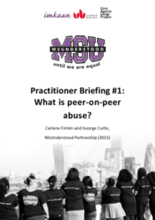Introduction
In recent years practitioners and policymakers have become increasingly concerned about the levels of violence and abuse between young people evidenced in UK research (Home Office 2011a, Home Office 2011b, Beckett et al 2014). The UK’s first study into teenage relationship abuse and exploitation found that one in three girls surveyed had experienced sexual violence from a partner before they turned 18 and 25% had been in physically abusive relationships (Barter et al 2009). Young people have reported physical, sexual and emotional abusing, and being abused, by their peers as a means of survival in gang affected neighbourhoods (Beckett et al 2013, Firmin 2011, Pitts 2008). A growing interest in child sexual exploitation has evidenced that a quarter of cases in many areas are peer-on-peer as opposed to adult on child (Berelowitz et al 2012, Barnardo’s 2011), with some areas suggesting that it is their most frequently identified model of exploitation (Beckett et al 2014). Most recently a European study found that more than four in ten teenage schoolgirls aged between 13 and 17 in England have experienced sexual coercion (Barter et al 2015).
Amidst this expanding evidence base, local practitioners and national policymakers are seeking solutions. This briefing outlines what current research tells us about the nature of peer-on-peer abuse, and considers what this might mean for building a response.

